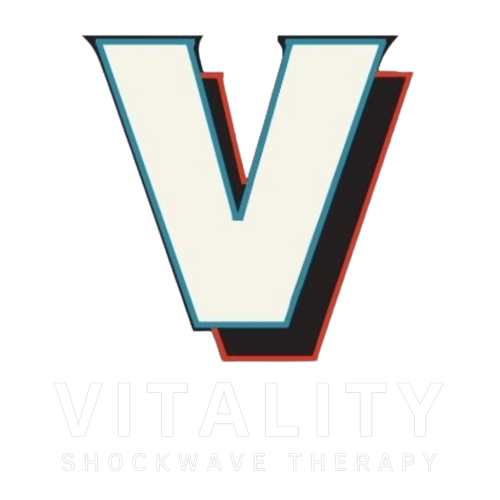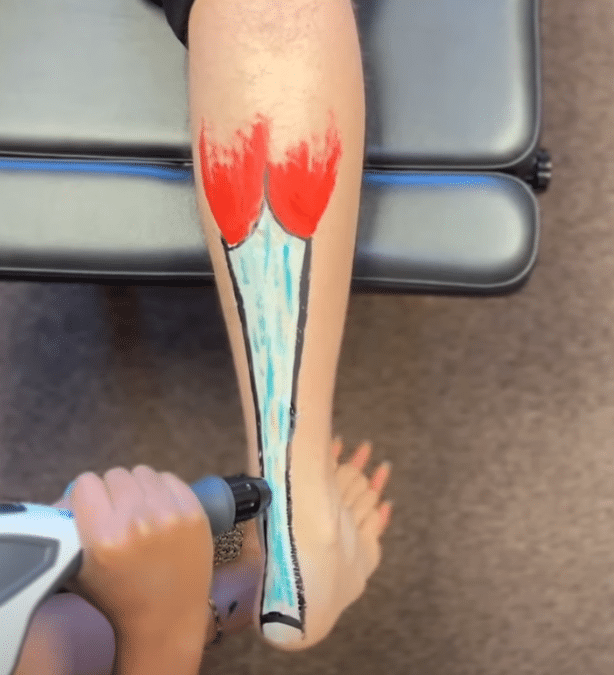Imagine this. You’re out for your regular run, when suddenly you feel a sharp pain in the back of your ankle – an uninvited guest that decides to stick around. A quick Google search tells you it’s likely Achilles tendinopathy, but what now? Do you give up running altogether or is there another way?
Welcome to Shockwave Therapy For Achilles Pain, where we’ll explore just how this innovative treatment can help bring relief and get you back on track. But hold on! This isn’t just about relieving pain.
Whether you’re suffering from chronic insertional achilles tendinopathy or noninsertional issues – we have got something here for everyone.
Let’s move forward.
Table Of Contents:
- Understanding Achilles Pain and Tendinopathy
- Exploring Shockwave Therapy as a Treatment Option
- Comparing Shockwave Therapy with Other Treatments
- Efficacy of Shockwave Therapy for Achilles Pain
- The Role of Shockwave Therapy in a Comprehensive Treatment Plan
- Conclusion
Understanding Achilles Pain and Tendinopathy
Achilles tendinopathy is a common issue, especially among runners. But it’s not just athletes who suffer – dancers report an occurrence of 9%, gymnasts see around 5%, while tennis players face this condition at about a rate of 2%. This pesky problem can occur in two forms: insertional and noninsertional.
Insertional Achilles tendinopathy, as the name suggests, happens where the tendon attaches to your heel bone. It affects both active individuals and those leading more sedentary lifestyles. On the other hand, noninsertional Achilles tendinopathy typically troubles younger, active people because it involves degeneration higher up in your calf muscles’ area.
The real troublemaker here is chronic Achilles tendinitis or chronic Achilles tendinopathy. It’s when pain becomes persistent over time due to untreated acute inflammation or recurring damage that hasn’t completely healed before being subjected to more strain.
Identifying Risk Factors for Achilles Tendinopathy
We often overlook factors contributing towards our health until they become evident problems; let’s make sure we’re not doing that with achilles tendonitis. Certain risk factors include biomechanical abnormalities such as leg length discrepancy (when one leg is longer than another) which leads to uneven pressure distribution during movement. Systemic conditions like high blood pressure can also play their part by impacting blood supply required for tissue healing.
Hill training might sound tempting but sudden increase in uphill runs are known culprits behind causing extra stress on your tendon – remember moderation is key.
Tendon Injuries Are More Than Just Painful Episodes
Experiencing pain in your heel or calf? You might be dealing with Achilles tendinopathy. It’s not just about the discomfort though; these injuries can limit mobility and hinder daily activities. Tendon damage, if ignored for long, can escalate to a point where you may need surgery – so better safe than sorry.
Key Takeaway:
Understanding Achilles Pain: Not just for athletes, Achilles tendinopathy is a common issue that comes in two forms: insertional and noninsertional. The chronic version of this condition can lead to persistent pain if left untreated or repeatedly strained before full recovery.
Risk Factors: Don’t overlook key health contributors, such as biomechanics. Understanding these elements can significantly impact your overall well-being.
Exploring Shockwave Therapy as a Treatment Option
Dealing with Achilles pain can be challenging, but there’s good news. An innovative treatment known as shockwave therapy has shown promise in relieving this discomfort.
This technique uses low-energy shock waves to stimulate healing within the tendon. It’s also known as extracorporeal shock wave therapy and it’s gaining popularity for its effectiveness against stubborn conditions like chronic insertional Achilles tendinopathy.
The National Institute for Health and Care Excellence (NICE) highlights that when traditional treatments fail, ESWT serves as an effective non-invasive alternative. This is especially true for those who have tried other conservative therapies without success.
The Application of Shock Wave Therapy
To apply this treatment, your therapist will use a device that generates shocks at specific frequencies and intensities on the affected area – typically where you feel most pain or tenderness. The idea behind using these controlled pulses is to encourage increased blood flow and promote cellular regeneration within the injured tissue.
Treatment Effects: What To Expect?
In terms of outcomes after undergoing such procedures, patients often report significant improvements in their condition post-therapy application.
A clinical study by Furia found that individuals suffering from insertional Achilles tendinopathy experienced more relief following shockwave therapy than physiotherapy alone—emphasizing its potency in alleviating symptoms related to tendon injuries.
Note:
- Shockwave therapy isn’t a quick fix—it’s part of ongoing care. You’ll need to keep up with exercises and possibly make some lifestyle changes.
- Like all treatments, it may not work for everyone. Shockwave therapy can provide a major decrease in suffering and an enhanced quality of life for those who have persistent tendon issues.
those who are dealing with stubborn tendon problems. Shockwave therapy can be a game changer, offering a fresh approach to pain relief and healing.
Key Takeaway:
Struggling with Achilles pain? Good news: shockwave therapy is a promising treatment. It uses controlled shocks to boost healing in the tendon, offering an effective option when traditional methods fall short. Expect three weekly sessions for maximum benefits and remember, its part of ongoing care. For many, this innovative approach can lead to less pain and better quality of life.
Understanding the Impact of Training Errors on Tendon Damage
The traditional first line of defense against Achilles tendon injuries often includes conservative treatments like activity modification and eccentric loading. These methods aim to reduce strain on the Achilles tendon while promoting a healing response within damaged tissue.
Eccentric loading exercises help strengthen your calf muscles which can lessen the load borne by your Achilles tendon during physical activities. On the other hand, activity modification usually involves adjusting your training regimen or lifestyle habits that may be contributing to undue stress on this vital tendon.
Standard treatment regimens recommend these interventions for initial management, but what happens when they don’t bring relief?
Shockwave Therapy: A Noninvasive Alternative
This is where shock wave therapy shines as an effective non-invasive alternative treatment option for chronic insertional Achilles tendinopathy sufferers who find little success in standard therapies. Using focused sound waves, shock wave therapy stimulates blood flow in affected areas and initiates natural repair processes at cellular levels.
Treatment Efficacy Comparison
In terms of efficacy, studies have shown shockwave therapy can outperform physiotherapy alone. In fact, patients reported improved function and less pain following shockwave therapy compared to those relying solely on exercise-based protocols like eccentric loading.
Key Takeaway:
When managing Achilles pain, traditional treatments like activity modification and eccentric loading might not always work. That’s where shockwave therapy steps in as a convenient, non-invasive alternative. By using focused sound waves to stimulate blood flow and natural repair processes, it often outperforms physiotherapy alone in improving function and reducing pain.
Efficacy of Shockwave Therapy for Achilles Pain
Dealing with Achilles pain? You’re not alone. But here’s some good news: shockwave therapy could be the answer to your prayers.
Shockwave therapy is a noninvasive treatment utilizing pressure waves to treat musculoskeletal conditions, such as chronic insertional Achilles tendinopathy, and promote pain relief and recovery. It’s a noninvasive treatment that uses pressure waves to treat various musculoskeletal conditions. High-energy acoustic waves (shock waves) deliver a mechanical force to the body’s tissues, helping alleviate pain and accelerate recovery in injuries such as chronic insertional Achilles tendinopathy.
The proof is in the pudding – or rather, in controlled trials. One study showed that this type of therapy has been more effective than physiotherapy alone at improving both pain and function in cases of insertional Achilles tendinopathy.
Clinical Outcomes Worth Noting
A number-cruncher might ask: “What are the hard stats?” Well, brace yourself for some numbers. According to research conducted by Furia J.P., 2006, there was significant improvement observed among patients treated with shockwave therapy compared with those who received traditional treatments only.
Patient satisfaction following treatment also played a big part. The same study revealed many participants reported improved quality of life after undergoing sessions of extracorporeal shockwave therapy.
Key Takeaway:
Shockwave therapy is a game-changer for Achilles pain. This noninvasive treatment uses pressure waves to treat musculoskeletal conditions, providing relief and speeding up recovery. Research shows it’s more effective than physiotherapy alone, with patients reporting significant improvements in both pain and function.
The Role of Shockwave Therapy in a Comprehensive Treatment Plan
Shockwave therapy, specifically extracorporeal shock wave therapy (ESWT), is becoming an increasingly popular noninvasive treatment option for Achilles tendinopathy. Its role within a comprehensive treatment program can be substantial.
Combining ESWT with traditional rehabilitation protocols enhances the healing response and promotes better recovery outcomes. This mixture of treatments not only helps to reduce discomfort, but also enhances the ability to move around and be active for those enduring both insertional and noninsertional Achilles tendinopathy.
Incorporating Rehabilitation Protocols With Shockwave Therapy
We’ve all heard the phrase “Teamwork makes the dream work”, right? Well, it holds true even when it comes to managing musculoskeletal pain.
The real magic happens when we team up different modalities – like eccentric loading exercises or physical therapies – along with our trusty sidekick, ESWT. It’s kind of like making your favorite sandwich; each ingredient plays its own important role, but together they create something deliciously effective.
Navigating Conservative Management Strategies Alongside ESWT
Now, let’s not forget about our old friends in conservative management. Strategies such as activity modification, pain management, and physiotherapy are still vital components of any comprehensive treatment plan.
The beauty of shockwave therapy is that it can be easily incorporated into these existing strategies without disrupting the overall flow. This creates a well-rounded approach to tackling Achilles tendinopathy from all angles.
Final Thoughts: Putting It All Together
Achilles pain doesn’t have to be a life sentence.
Key Takeaway:
Shockwave therapy, or ESWT, is changing the game for Achilles tendinopathy treatment. Paired with traditional rehab protocols, it not only eases pain but also boosts function and mobility. It’s about teaming up different methods – like physical therapies and activity modification – to create a comprehensive plan that hits all angles of your Achilles pain.
Conclusion
So, we’ve traversed the path of Achilles pain and tendinopathy together. From understanding its complex nature to exploring the role of Shockwave Therapy For Achilles Pain in a comprehensive treatment plan.
We’ve highlighted that shockwave therapy is not just about relief – it’s also about recovery and rehabilitation. It has been shown as an effective non-invasive option when other treatments fail, helping you regain your stride.
We would love to help. Schedule your appointment by calling 630-499-4078 or click here https://www.schedulicity.com/scheduling/VCCB5R

